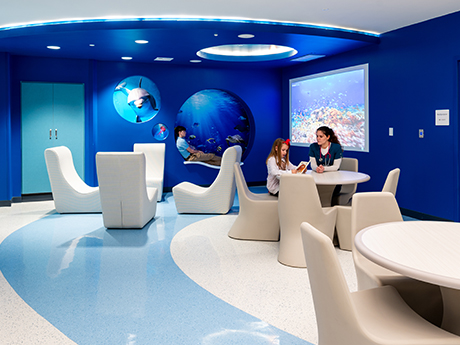By Erik Higgins and Tiffany Kalloor, associate principals at Hoefer Welker
While providing top-quality patient care can never be replaced as a priority, the design of healthcare facilities is a major factor in creating an overall environment that supports healing and well-being for patients and staff.
In the ever-evolving landscape of healthcare real estate design, new trends continue to reshape how providers utilize facilities. This is particularly true for behavioral healthcare spaces. It is crucial to have architecture, engineering and construction (AEC) partners who share a commitment to empathetic and flexible design, incorporating diverse viewpoints and staying current with changing technology.

Healthcare organizations expect design plans that are at the forefront of innovation and that extend beyond functionality — designs that benefit the holistic patient experience. With bespoke patient spaces, designated areas for employee wellness, the integration of biophilic design and state-of-the-art technology, the behavioral health design landscape is rapidly adapting. This requires balancing escalating construction and renovation costs and amenities no longer considered optional.
Recently, we’ve seen the following features successfully incorporated into designs of healthcare facilities:
Personalizing Patient Experiences
Behavioral healthcare facilities have become committed to providing options for patients to personalize their rooms. Whether it’s lighting, art or sound adjustment capabilities, many small elements can significantly influence a patient’s comfort. The goal is to have tailor-made design elements for each space, ensuring the room is functional for the staff and unique to the patients who use it.

Forgoing a one-size-fits-all approach, these personalized amenities are crucial to the treatment journey. Rooms should adapt to individual patient needs or potential sensitivities with options for personalized care. In acute care behavioral health settings, patients are often not self-admitting. Providing patients with a sense of dignity and a degree of control over their environment leads to better outcomes.
We incorporate customizable lighting, noise-reduction technology and art installations to accommodate various sensory needs or disabilities. Patients can utilize colored lighting with cool or warm tones that enhance their emotional state. Art and imagery within the facility serve as positive distractions.
Rest is another important contributing factor to healing, which can be difficult due to background noises from machinery, neighboring patients or personnel. Acoustics play a significant role in creating spaces for patients to rest by helping to counteract outside noises and maintain a calm environment. From implementing sound-making through white noise machines to providing access for patients to music therapy, we’ve seen the positive impact that auditorial amenities can make.
These personal touches provide a sense of home and comfort during times of uncertainty and can benefit overall outcomes. From making pediatric spaces more inviting to creating more comfortable oncology care, the benefits of personalization can completely transform a patient’s experience.
Enhancing Staff Well-Being
The demands imposed on healthcare staffers to quickly understand and adapt to patient circumstances and needs can prove stressful and emotionally taxing.
Dedicated spaces for rest, relaxation and privacy support the mental and physical well-being of the healthcare staff. These areas have become essential for modern, successful healthcare facilities as they help attract and retain top talent. The inclusion of these spaces further enhances patient care by allowing caretakers and providers opportunities to reset and recharge.
Healthcare workers perform better and provide higher-quality care when they have engaging work environments and support for both productivity and psychological well-being. Studies indicate this approach also fosters increased trust between staff and management.
Incorporating Biophilic Design
Biophilic design, an architectural approach to connecting a space’s occupants with the natural environment, employs a multifaceted process that engages the five senses. Examples include emphasizing natural lighting, materials and furniture selections, creating thoughtful floor plans and implementing wall curvatures that mirror the interconnectivity between the outdoors and interior space.
Professionals in the AEC fields have unique opportunities to play critical roles in supporting better medical outcomes by integrating these elements into healthcare design. Providing patients access to views of nature and greater control over their environment can lead to improvements in their mental and physical health.
This approach also enhances the staff and visitor experience. While natural light has several benefits for the body and mind, views of the outdoors and access to patios and gardens also provide a calming and peaceful environment that allows for an escape from the often complex and emotionally taxing circumstances surrounding treatments.
Catering to Patient Needs
The healthcare industry evolves at an accelerated rate due to associated technological advancements. Balancing modern treatment approaches with traditional patient care — all while maintaining efficient operations — presents unique challenges.
Whether through producing sophisticated designs that incorporate medical equipment or updating security and day-to-day processes, technology plays a major role in the setup of healthcare facilities. For example, the layout of the typical nurses’ station has changed. Instead of having one large central area for entering data into a desktop computer system, mobile stations taken from room to room have become increasingly common. The new focus for a nurses’ station often involves individualized areas with spaces to physically and emotionally reset or collaborate.
Having a clinical technology solutions (CTS) team to work alongside when designing and crafting healthcare spaces ensures that the proper medical equipment, including IT, security, audiovisual and clinical communications, are fully integrated into the facility design, construction and operations. These teams help incorporate revolutionary designs that have changed the medical care for many communities.
For example, our team at Hoefer Welker ran into the issue of having mounted TVs in behavioral health patient rooms where some patients don’t need access to these devices. We sought to create a ceiling-mounted projector, allowing patients and providers optional use for TV, movies or training but with the flexibility to conceal the feature when necessary.
No existing solution existed on the market at the time, so our team created one, with the client, general contractor, subcontractor and CTS team. Bringing this schematic design to life proved that innovation and adaptability can create industry-leading technology that enhances patient care.
Conclusion
Behavioral healthcare design and construction trends will continue to evolve and to be influenced by other industry sectors. Expanding beyond traditional solutions focused on functionality and cost creates collaborative opportunities to enhance personalized care, support healthcare professionals, integrate natural elements and effectively use advanced technology.
Mental and physical health have equal influence on the design of innovative healthcare spaces. As such, AEC professionals must continuously adapt strategies and best practices to keep pace with this evolution, especially for some of our most vulnerable populations of patients.


